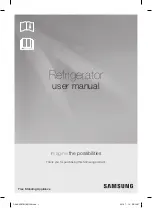
34
3. Evacuation
1) Attach a vacuum pump to the system. Be sure to connect the charging hoses to both
high and low-side refrigerant piercing valves.
IMPORTANT
The vacuum level and vacuum pump may be the same as those for current
refrigerants. However, the rubber hose and gauge manifold to be used for
evacuation and refrigerant charge should be exclusively for POE oils.
2) Turn on the vacuum pump, then open the gauge manifold valves. Never allow the oil in
the vacuum pump to flow backwards.
3) Allow the vacuum pump to pull down to a 29.9" Hg vacuum (500 microns). Evacuating
period depends on pump capacity.
4) Close the low-side valve and high-side valve on the gauge manifold.
5) Disconnect the gauge manifold hose from the vacuum pump and attach it to a
refrigerant service cylinder. Remember to loosen the connection and purge the air
from the hose. For the required refrigerant charge, see the nameplate. Hoshizaki
recommends only virgin or reclaimed refrigerant which meets ARI Standard 700 (latest
edition) be used.
4. Recharge
6) R-290 can be charged in either the liquid or vapor state.
Liquid charge is preferred. If refrigerant charging is done in the liquid state, place the
service cylinder on the scales;
if the service cylinder is not equipped with a dip
tube, invert the service cylinder, then place it on the scales.
Open the high-side
valve on the gauge manifold.
7) Allow the system to charge with liquid until the proper charge weight is met.
8) Close the high-side valve on the gauge manifold. If charging is complete, skip to step 10.
9) If necessary, add any remaining charge to the system through the low-side. Plug the
appliance into the electrical outlet. Allow the compressor to energize.
NOTICE!
To prevent compressor damage, use a throttling valve or liquid
dispensing device to add the remaining liquid charge through the low-side
refrigerant access valve with the compressor energized.
Close the refrigerant
cylinder valve and let the low-side refrigerant equalize to the system, then close the
low-side manifold gauge. Unplug the appliance from the electrical outlet.
10) Pinch off (crimp down) the process tubes just below the piercing valves.
11) Remove the piercing valves. Cut the process tubes to remove the piercing valve holes
then braze the process tubes closed. Note: Be sure there is no refrigerant leak before
brazing.
12) Use a combustible gas leak detector or soap bubbles to check for leaks again.
13) Place red sleeves over the process tubes.
14) Plug the appliance back into the electrical outlet.
Содержание Steelheart B Series
Страница 39: ...39 B Wiring Diagrams 1 UR WR27 UR WR36 UR WR48 except glass door and SR36 ...
Страница 40: ...40 2 UF WF27 SR27 and SR48 ...
Страница 41: ...41 3 UR WR48 glass door UR WR60 and UR WR72 ...
Страница 42: ...42 4 UF WF48 UF WF60 SR60 and SR72 ...









































